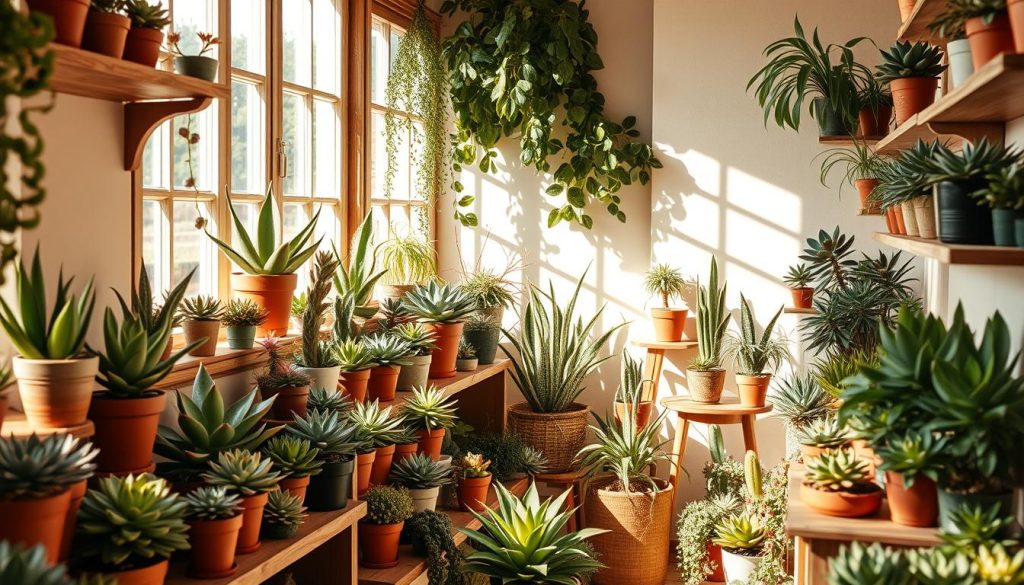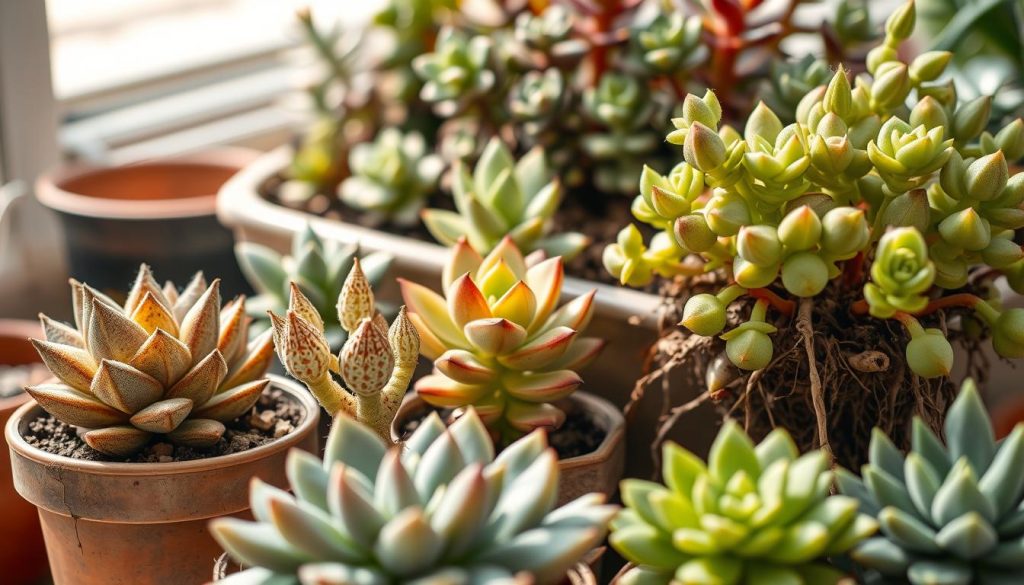Discover the Beauty of Succulents: A Guide for Beginners
Welcome to the world of succulents! They’re great for anyone new to gardening or looking to add some green to their space. Succulents store water in their leaves, so they don’t need much care. This makes them perfect for busy people.
Their popularity is growing fast. The global houseplant market is expanding by 20% every year. This is because more people are choosing succulents for their easy care.
Succulents can thrive in many places, from sunny windows to outdoor gardens. They’re small, making them great for tiny spaces. Plus, they come in many different types, offering endless design possibilities.
These plants can grow in many places, from deserts to mountains in Europe. They belong to 60 different plant families. This shows how well they can adapt to different environments.
Key Takeaways
- Succulents need watering only when soil is completely dry to avoid root rot.
- They prefer bright indirect light but can survive in low-light spaces.
- Over 20,000 varieties exist, ranging from cacti to echeveria species.
- They require 20% less water than typical houseplants, making them ideal for busy lifestyles.
- They’ve become a social media sensation, driving a 20% annual market growth since 2020.
What Are Succulents?
Succulents are plants that store water in their leaves and stems. They can survive in dry conditions. These plants come in many shapes and sizes.
They are found all over the world. From South Africa’s Karoo region to California’s coastal areas, succulents thrive.
Definition and Characteristics
Succulents store moisture in special tissues to survive drought. Some, like Glottiphyllum, can hold up to 95% water in their leaves. They have thick, fleshy leaves and waxy coatings to keep water in.
They grow in a rosette shape and grow slowly. This helps them conserve resources.
Popular Types of Succulents
Here are some easy-to-grow succulents:
- Echeveria: Colorful rosettes with pink and blue hues
- Aloe Vera: Has medicinal gel inside its leaves
- Jade Plant (Crassula ovata): Known for good luck with glossy leaves
- Sedumum: Great for ground cover in gardens
- Haworthia: Small, spiky leaves with unique patterns
Cacti are also succulents but are often seen as different. Many succulents change color when stressed. They might turn red or purple in the sun or when it’s dry.
Benefits of Growing Succulents

Indoor succulents are more than just decorations. They make spaces better and improve our health. They help us focus and clean the air, showing their value beyond size.
Aesthetic Appeal
These plants bring style to any room with their bold shapes and colors. They fit well in both simple and modern decor. Jade plants and haworthia are great for adding a touch to desks or bookshelves.
Low Maintenance Requirements
These plants are perfect for those with busy lives. They only need watering every 1–2 weeks, depending on the light. They can handle a little neglect, thanks to their ability to survive without much water.
They thrive in well-draining soil and bright, indirect light. This makes caring for them easy and stress-free.
Air Purification
Research shows they are natural air filters. NASA found they remove harmful chemicals from the air. Some plants, like snake plants, even release oxygen at night, helping us sleep better.
They also help by reducing allergy triggers and improving humidity. This makes them great for people with dry skin or allergies. Plus, they can lower stress levels, making them perfect for stressful places like offices or bedrooms.
How to Choose the Right Succulent
Choosing the right succulent means matching your space and style to the plant’s needs. First, check your environment’s light, space, and care routine. This will help you pick the best varieties.
Factors to Consider
- Light and Space: Choose plants based on light needs. Shade-loving succulents like Haworthia do well in low light. Echeveria prefers bright spots.
- Pot Quality: Pick succulent pots with drainage holes. Terra cotta is good for breathing, while glazed ceramic adds style. Stay away from pots without holes to avoid root rot.
- Size Matters: Big succulent plants (like Agave) need large pots but water less often. Small pots (4-inch) dry faster, so watch them closely.
Where to Buy Succulents
Look for healthy specimens at local nurseries, online sellers, or plant swaps.
- Local Nurseries: Many nurseries now carry a variety of succulent plants due to growing demand. Oasis Water Efficient Gardens in Escondido pairs plants with ceramic artist Pat Roach’s pots.
- Online Retailers: Sites like Surreal Succulents and Plants Guru have rare varieties. Check photos for healthy leaves and read reviews before buying. Clean new plants with a soft brush if they’re dusty.
- Pro Tips: Don’t buy root-bound plants. Replant them right away in fresh, well-draining soil. Choose pots with earth tones like terracotta or teal to match your greenery.
Basic Care Guidelines for Succulents
Learn the basics of succulent care. These steps will help your plants thrive. They need the right amount of water, light, and soil.
Watering Tips
Succulents can’t handle too much water. Here’s how to water them right:
- Check if the top 1.25 inches of soil are dry by poking it with your finger.
- Water until it drains out the pot’s bottom holes, then wait for the soil to dry completely.
- Adjust your watering based on the season:
- Summer: Water every week
- Spring/Fall: Water every two weeks
- Winter: Water once a month
Light Requirements
Most succulents need 6 hours of sunlight a day. Here’s how to adjust:
- Place them near south- or west-facing windows for bright, indirect light.
- New plants need 1-2 weeks to get used to sunlight to avoid burning.
- Variegated plants prefer partial shade. Avoid direct sunlight in the middle of the day.
Soil Selection
Choose soil that drains well to prevent root rot. Here are some options:
- Premixed cactus/succulent soil from garden stores.
- DIY blend: Mix 1 part potting soil, 1 part sand, and 1 part pumice or perlite.
- In-ground: Use 1/3 garden soil, 1/3 compost, and 1/3 pumice.
Make sure your pots have drainage holes. Don’t use regular potting soil alone—it holds too much water.
Common Mistakes to Avoid
New gardeners often make simple mistakes in succulent care. Overwatering is the main reason for plant loss, affecting 25% of indoor plants. Spotting issues early can save your plants.

- Overwatering: Mushy leaves or black stems mean root rot. Soil should dry completely before watering. Use pots with drainage holes and terracotta to wick away moisture.
- Lighting Errors: Pale, stretched stems mean too little light. Scorch marks show sunburn. Place plants in indirect light for 6 hours daily. Rotate pots weekly to prevent leaning.
- Poor Drainage Myths: Adding pebbles to pots without drainage holes worsens moisture retention. Always use pots with drainage. Root rot is irreversible once started.
- Incorrect Pairings: Mix cacti with other succulents cautiously. Ferns and jade plants need different watering schedules. Keep them separate to avoid stress.
- Temperature Neglect: Frost-sensitive varieties like jade plants need indoor shelter below 50°F. Agave species may triple in size, so replant them in larger pots as they grow.
Leggy Aeoniums regain vigor with pruning and brighter light. Check soil moisture with a meter before watering. Most succulents recover with adjusted care—just act early to save your plants.
Propagating Succulents
Succulent propagation is a fun way to grow new plants from old ones. It’s great for filling spaces or sharing with friends. Start with healthy plants and follow these steps for success.
Methods of Propagation
- Leaf propagation: Gently twist off plump leaves from the base. Let them dry 3-5 days until calloused. Plant half-inch deep in well-drained soil.
- Stem cuttings: Trim stems 3-4 inches long. Let ends dry until scabbed. Plant in cactus mix and water sparingly until roots form in 3-4 weeks.
- Offsets/pups: Separate baby plants growing at the base of the mother plant. Plant individually once they have roots.
Timing and Techniques
Spring and summer are the best times for most species. After cutting, let wounds heal fully. Bury stems or leaves no deeper than half an inch. Water only when soil is fully dry—overwatering causes rot.
Roots appear in weeks, and full plants may take 2-3 months. For tropical varieties like pothos, water propagation works well: place cuttings in jars and roots form quickly.
Some plants like spiderettes (spider plant babies) root in soil, while snake plant leaf sections need to be buried vertically. Patience pays off—each stem can yield multiple new plants. This makes succulent propagation a cost-free way to expand your garden. Try experimenting with different methods to see what works best for your collection.
Designing with Succulents
Transform spaces indoors and outdoors with succulents. These plants are perfect for vibrant gardens or adding greenery to rooms. Choose outdoor succulents that fit your climate. USDA zones 9 and 10 are great for year-round growth.
Creating a Succulent Garden
Use drought-tolerant plants to save water. Mix trailing plants with rosette shapes for texture. Layer pots of different sizes for depth.
Group plants by color for a beautiful look. Rock gardens or borders highlight their shapes. Mix evergreen and blooming plants for all-year interest.
Using Succulents for Indoor Décor
Indoor succulent pots brighten up any space. Choose shallow pots with holes for drainage. Bold plants like zebra cacti make great focal points.
Cluster small succulents in terrariums. Vertical planters add height. Kokedama balls save space and look great in windows.
Mix colors for striking displays. Books like *Designing with Succulents* by Debra Lee Baldwin inspire plant arrangements.
Troubleshooting Succulent Problems
Succulent plants can face challenges even with careful care. Spotting issues early helps keep your collection healthy. Let’s break down common problems and how to fix them.
Identifying Pests
Check plants weekly for these common pests:
- Mealybugs: Cottony white clusters on stems or leaves. Wipe with alcohol-soaked cotton swabs.
- Fungus gnats: Small black flies near soil. Let soil dry completely between waterings.
- Aphids: Tiny insects on new growth. Spray with a neem oil solution.
Common Diseases and Solutions
Watch for these signs and adjust care:
- Root Rot: Yellowing leaves and mushy stems signal overwatering. Repot in dry soil and let roots air-dry before replanting.
- Sun Scorch: Brown patches on leaves mean too much direct sun. Move plants to indirect light and trim damaged areas.
- Stretching Growth: Tall, spindly stems indicate low light. Relocate to a brighter spot or use full-spectrum grow lights for 12–16 hours daily.
Always isolate new plants for two weeks to prevent pest spread. Most issues reverse with timely action. Patience and consistent care ensure your succulent plants thrive again.
Resources for Succulent Enthusiasts
Expand your knowledge of succulent gardening with trusted resources. Connect with others who love succulents as much as you do. These tools will help you grow as a gardener.
Books and Websites
Begin with Designing with Succulents, a guide with over 70 Aloe species photos and landscaping tips. Check out Ponderosa Cactus’ website for care guides and shop their collection online. Subscribe to the “Celebrating the Joy of Succulents” newsletter for a free PDF of easy-care plants.
Follow their YouTube channel with 100+ videos on propagation and care. Online forums and blogs like Succulent Guide and Cacti Mall offer daily tips for thriving collections.
Local Workshops and Communities
Join local workshops at botanical gardens or visit Ponderosa Cactus’ Tucson nursery for advice. Search community boards for plant swaps and gardening clubs. These spaces foster friendships and problem-solving, like managing pests or selecting companion plants.
Many groups host seasonal events, perfect for learning and inspiration. From books to online videos, these resources turn curiosity into confidence. Explore further, ask questions, and let your succulent garden flourish with community support.